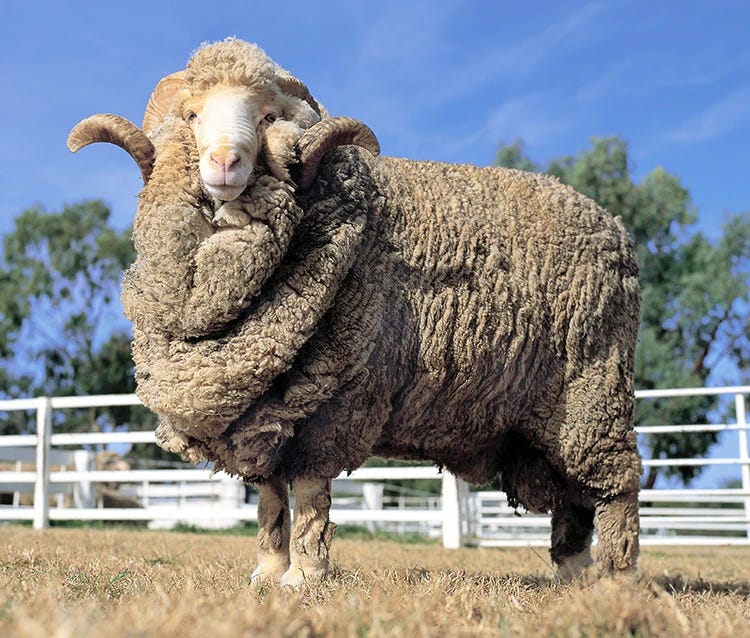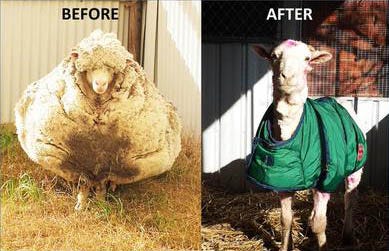Consider: Merino Wool
Not a baaaaaaad idea.
As always, welcome to our new readers! Today’s newsletter is a collaboration between Kevin Kelly and Jared Gordon on a topic close to our hearts, both physically and emotionally: merino wool.
Everyone who knows Kevin knows of his deep love for merino. He’s been a merino evangelist for over 15 years (with no vested commercial interest - pun intended) and sincerely claims “merino has changed my life”. Merino has a fascinating history that takes us from Spain to Australia and back to North America.
I’ll let Kevin tell the story of his discovery:
“15 years ago, I was in New Zealand visiting a friend. We did something I have only ever done that one time - go heli mountain biking. We were dropped on the top of a mountain with our bikes and two rad dads led us down a trail. I was both freezing and sweating the whole time. The guides were fine and I later discovered it was because they were wearing Icebreaker merino quarter zips. I picked some up and have not looked back. I’ve been temperate and odourless since. It’s the most comfortable material you can wear… underwear, socks, t-shirts, button-up shirts, sweaters, anything you can imagine. At first my friend’s thought I was nuts, going on about how I could ski in a sweater and then wear it to the bar and then to the office the very next week… eventually I converted them all to the merino way.”
Merino wool has exploded in popularity and availability since then. Read through to learn about its history, key properties and how you too can buy great merino products.
Design
Wool has been prized as a fabric for more than 9,000 years. Must have been a massive upgrade in loincloth comfort. Roughly 6,000 years ago, farmers started to breed for “wooliness.” That breeding eventually led to this beauty:
North African goat herders brought the ancestors of merino sheep to Spain in the 1400s (maybe they were also packing watermelons). With careful cultivation and breeding, merino wool became the primary export of Spain for over 400 years. The sheep were prized for the softness of their wool, so much so that exporting merino sheep was punishable by death until 1797. The only way to get one was if it was gifted by the court.
Two kinds of sheep emerged from this breeding program: settled and transient. The settled sheep had to deal with winters, so they developed coarser wool. The transient sheep migrated with the warm weather and adapted over time to have very fine coats. The sheep would travel over 400 miles in groups of 10,000 at a rate of as much as 20 miles a day. Because they were royal sheep, they could trample over anyone’s land. The cañadas, which are traditional rights-of-way for sheep that perhaps date back to prehistoric times, are legally protected “forever” from being built on or blocked and now form a national trail network. Skipping the PCT, I am going to walk the cañada in Spain and give myself the trail name of Don Quixote.
The fineness of the coat is important to the merino narrative. The finer the hair that makes up the fleece, the softer the ensuing product.
In 1797, the sheep that would inspire the Australian sheep industry arrived from South Africa. A cargo hold of sheep descended from a breeding pair (gifted to Prince William of Orange in the Netherlands by King Carlos III of Spain) was loaded aboard two ships captained by John Macarthur. Macarthur was careful to make sure that the merino sheep did not cross breed with other varieties and so he became the father of the Australian wool industry.
By 1803, he had 4,000 heads of sheep. By 1840, merino were so plentiful in Australia that thousands were being shipped over yearly to New Zealand.
Macarthur secured agreements to supply the British government wool for uniforms in the Napoleonic wars (an arrangement that was repeated again in WWII). Wool became 56% of Australian agricultural production. With only 10% of the world’s sheep, Australia produces 50% of the world’s fine wool.

Innovation
Merino’s magical properties have seen its wide adoption in outdoors and performance apparel. The fibres have many crimps and bends which, like goose down, trap air. That air heats up and keeps you warm. As well, all those little bends are very helpful when you are sweating. The larger surface area ensures that your sweat is wicked away and the evaporation process is accelerated, leaving you feeling cooler and dry. If my simplification of the science leaves you with questions, the New Zealand wool board has a great analysis, including scholarly references.
Merino is also known for its ability to suppress body odours. Sweat by itself doesn’t smell (says, science?). If sweat sits on the skin, bacterias form and their waste product includes odour causing fatty acids. Merino's rapid absorption rate and fast evaporation eliminates the sweat quickly enough that there is no smell. I have never found that this has worked for me, but others (like Kevin) rave about it.
The benefits of merino are only fully realized through merino being the layer closest to your skin. If you are layering with merino as the outer layer, the benefits are greatly reduced.
The oldest merino apparel company I could find is Woolpower. Started in 1972, they began making merino clothes to supply to the Swedish army to keep them warm. Sourcing wool in Patagonia, they continue to manufacture in Sweden, with every garment hand-signed by the seamstress that made it.
Following that, there is a 20 year gap until the founding of Icebreaker and Smartwool. Both have since been acquired by VF Corporation, the holding company that owns everything from the North Face to Supreme. VF is actually worth considering on its own. They have always had a multi-brand strategy and in 1970, in an effort to get rid of excess inventory, they invented the outlet mall!
In the 90’s, merino wool was primarily sold to be blended with other wools. The founders of Icebreaker and Smartwool were able to convert a low value commodity product into something that is now sought after on its own. While still the leaders in the space, the use of merino has now become commonplace in all different kinds of apparel.
Sustainability
The merino industry has always used sustainability as a major selling point. It is an alternative to polyesters and other synthetic fabrics, which are produced with petrochemicals. Many producers provide in-depth tracing and information about where the wool came from and how the sheep were raised.
Icebreaker apparel used to have a “Baacode” program which featured a code on each item of apparel that you could enter into their website to trace the wool right to the sheep farm in New Zealand where it was produced. Kevin once stayed on the farm where the wool for one of his shirts came from. As the company has scaled, they’ve replaced this program with overall transparency and identification of their “growers”.
The increased popularity of merino has led to practices like blending and untraceable sourcing. The “72 Hour Shirt”, a popular merino T produced by Huckberry, is made from 87% merino wool and 13% nylon. This has the benefit of increasing durability but also lowers the efficacy of the wool's natural properties and increases pilling.
Look for Merino raised in places like New Zealand, Australia, South Africa and Patagonia. Many brands source from a company called Global Merino, which is audited for ethical supply chain practices. Look for brands that prohibit mulesing in their supply chain. Mulesing is a controversial practice to prevent infection that can be quite painful to the animal.
Cost
Merino can be found at a variety of price points. Uniqlo, the Japanese mass fashion purveyor, has a number of merino sweaters for less than $50. They have two kinds, a cotton merino blend and a 100% merino offering with no origin information (and unfortunately they also did not reply to inquiries about where they source from).
Kevin’s favourite merino brand is Icebreaker. Their 100% merino t-shirts start at $75 USD. Outlier is a popular pick for travellers and people who want a less obviously athletic shirt. They start at $120 USD per shirt.
Personally, I am a fan of Woolpower. I purchased my first Woolpower Sweater at a livestock fair almost ten years ago. It has not pilled, has survived many washings and has travelled the world with me. If you can wrap your head around the grandpa-esque styling, their sweaters will last you a long time.
If you want to “dip your toe” into merino, socks are a great place to start. The rubbing and abuse that socks endure require that they be made from blends. I have a number of pairs of Darn Tough socks. Terrible name and even uglier product, but they carry a lifetime warranty, which I have never had to test.
PS:
Meet Chris the Sheep. He was found wandering one day and had a massively oversized coat. He became a cause-celeb and it was estimated that it had been 5 years since his last shearing. Four-time Australian Shearing Championship winner Ian Elkins volunteered to shear the massive ram and got a 41kg fleece, enough for 30 “jumpers.” It is the world record for most wool ever produced by a single sheep and the fleece is a popular exhibit in the Australian museum. The before and after makes me wonder if I should shave my body? 200 likes and I will consider it.









